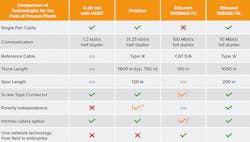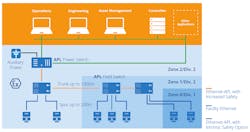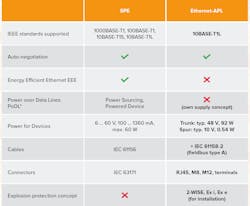Ethernet-APL in the field of process automation—the easy way
Ethernet-APL is ready to be used as the next standard for field applications, including installations in hazardous areas. It has been developed based on the requirements from end user organizations like NAMUR. Besides key features like 10 Mbit/sec. communication bandwidth, two-wire cabling with power for field devices, one of the major advantages is "easy to use."
Let's have a look at what makes Ethernet-APL the most optimal solution. (Figure 1)
Installation made easy with Ethernet-APL
New technologies often require new installations, special know-how and effort to dismantle the existing technology. All these points lead to high additional costs, which make investment highly complex and risky. Ethernet-APL has been developed with a different approach: it should easily fit in the existing process automation topology—without additional costs, such as for staff training or installation of new cables and connectors.
Figure 2
1. Standard connectors can be used. Ethernet-APL does not require any special connectors or connection technologies that may need dedicated tools for assembly; it uses standard and Proven in Use screws or spring clamp connectors, as well as common M8 or M12, and even RJ45 is possible for non-powered connections. That also means that companies do not have to train their operational staff to use new tools and processes.
2. Existing fieldbus installations can be re-used. Cables rom existing fieldbus installations with Foundation Fieldbus H1 and PROFIBUS PA can be reused and among others, Ethernet-APL also supports the IEC61158-2 type A specification. Companies can save a lot of time and money using the existing installations but simultaneously take advantage of a new technology.
3. Fits into hazardous areas and large installations as well as compact ones. The network installation can be based on the trunk-spur topology, which is well known from fieldbus installations. The power switch typically installed in the control room converts a 4-wire Ethernet networking into the 2-wire Ethernet-APL trunk and supplies up to 92 W to the network. Multi-spur field switches get power over the trunk, connecting and supplying the field devices.
With a maximum of 1000 m trunk length and up to 200 m spur length, the topology shows in figure 2 is ideal for large installations and long distances. For installations in hazardous areas, such field switches are certified for installation in Zone 1 or DIV 2 and with spurs supporting explosion protection techniques like "intrinsic safety" for field devices even in Zone 0 or DIV 1.
Installations in a more compact layout may also use the pure star topology (figure 2), which is well known from Ethernet. Here the field switches themselves are connected to a 4-wire Ethernet network, while the field devices are also connected to the spurs including their power supply. This allows an even simpler integration into existing Ethernet backbones but requires a separate power supply for each field switch. Explosion protection like intrinsic safety for field devices is available as well.
Figure 3
Facilitated explosion protection
Ethernet-APL supports various explosion protection techniques and can be used with different field devices in hazardous areas. However, intrinsic safety is one of the most favorable types of protection when it comes to process automation. Intrinsically safe devices are easy to handle—installation, modifications or maintenance can be completed easily.
The new 2-WISE explosion protection (2-Wire Intrinsically Safe Ethernet) for Ethernet-APL enables the use of field devices up to Zone 1 as well as DIV 1. Using standardized Ex I safety parameters, Ethernet-APL devices from different manufacturers can be interconnected within the framework of the specified boundary conditions of Ethernet-APL or 2-WISE without calculatory verification of intrinsic safety and without taking cable parameters into account.
Ethernet-APL is based on the well-known and proven in use industrial Ethernet technologies which allow the utilization of standard Ethernet components, tools and expert knowledge and combine this with comfortable new solutions dedicated to the process automation requirements. This is why Ethernet-APL is better than any other solution from the past and will become the standard for digital network installations in process plants very soon.
Figure 4: Ethernet-APL is a variation of 2-wire Ethernet that has been optimized for the process industries. Compare the features of standard SPE versus Ethernet-APL.




